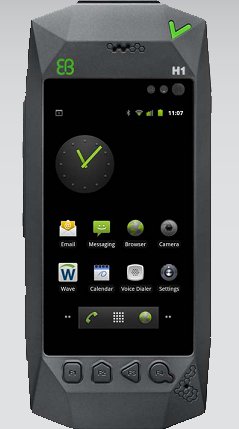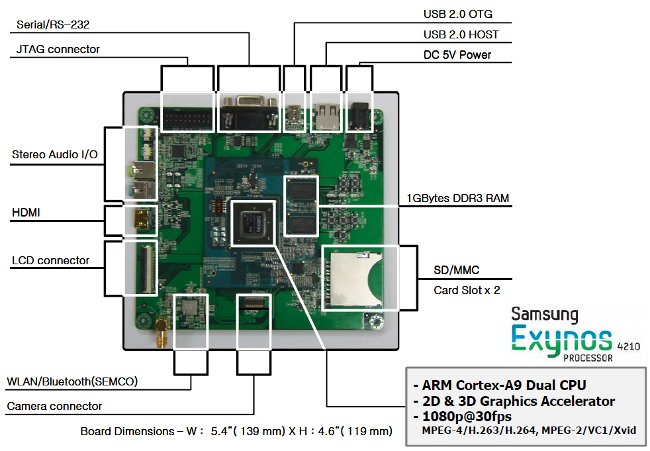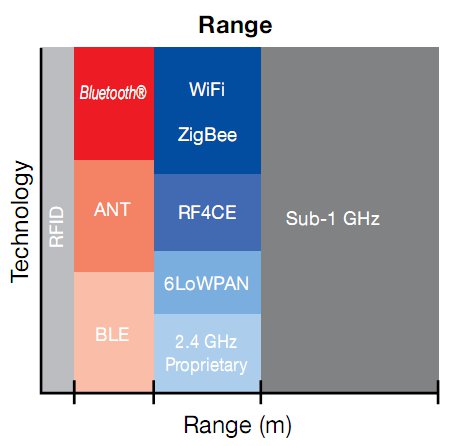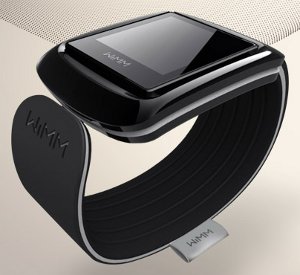Elektrobit (EB) announced their Specialized Device Platform (SDP), a reference design based on the Android operating system, targeted to Public Safety, Security and Defense, sectors with stringent compliance and regulatory requirements. The platform consists of form factor hardware that can be tailored to customer requirements. The current SDP has a TI OMAP 3 application processor, a high resolution touch-screen enabled display, Wi-Fi, Bluetooth, GPS, 2G and 3G modems – LTE for Band 14 being an option and runs Android 2.2 (Froyo). A version with TI OMAP 4 processor running Android 2.3 (Gingerbread) will be available in H1 2012. Linux Angstrom will also be provided for the platforms. Here are the details specifications of both reference platforms: OMAP3xxx ARM Cortex-A8 core up to 1 GHz ARM TrustZone compatible security engine NEON™ SIMD coprocessor POWERVR™ SGX graphics accelerator TMS320C64x+™ DSP up to 600 MHz OMAP4xxx Dual ARM Cortex-A9 cores up to 1.5 […]
Fix “Static Random Posts Widget” WordPress Plugin Page Not Found (404) Error
If you are using the latest version of Static Random Posts Widget (Version 1.1) an HTTP Error 404 (Page not found) will be generated although the plugin works fine. The 404 error may slightly delay your page load, you can check if you have the issue with PageSpeed Online. If you have such issue “Avoid bad requests” should appear in the results with the faulty link to http://yourblog.com/wp-content/plugins/static-random-posts/js/static-random-posts.js?ver=1 The reason for the error is the plugin is actually installed in plugins/static-random-posts-widget. To fix the issue, edit ./wp-content/plugins/static-random-posts-widget/static-random-posts.php and look for path declarations with static-random-posts and change it to static-random-posts-widget. Alternatively, you can download static-random-posts.php.bz2 I modified and uncompress it to replace static-random-posts.php. Please backup your file first. Jean-Luc Aufranc (CNXSoft)Jean-Luc started CNX Software in 2010 as a part-time endeavor, before quitting his job as a software engineering manager, and starting to write daily news, and reviews full time later in […]
Skype Adds Video Calling Support for 17 Android Devices
Last week, Skype announced that it is adding video calling support for 17 Android devices that run Gingerbread (Android 2.3). Previously, mobile video calling with Skype was only available on 4 Android devices namely: HTC Desire S Sony Ericsson Xperia neo Sony Ericsson Xperia pro Google Nexus S. Users can download Skype 2.1 for Android in order to make video calls with their smartphones and/or tablets if they are part of the following list: Acer A5 HTC Desire HTC Desire HD HTC Evo 3D HTC Evo 4G HTC Flyer HTC Incredible S HTC Sensation HTC Thunderbolt LG Revolution Samsung Droid Charge Samsung Galaxy S Samsung Galaxy S II Samsung Galaxy Tab Sony Ericsson Xperia mini pro Sony Ericsson Xperia Play Sony Ericsson Xperia ray. Skype also said that most users running Android 2.2 should still be able to enable video calling in their Skype settings. Skype 2.1 for Android detects […]
Low Cost Development Board Samsung Origen based on Exynos 4210
Late May, Samsung and Linaro announced Samsung Origen, a low cost development board (199 USD) based on Samsung Exynos 4210, that will use Linaro software and related development tools. This development board is mainly targeted for the development of products such as tablets, smartbooks, IVI, smartphone and other consumer products. Here are the technical details of the board: Cortex-A9 1.0 GHz Dual Core & NEON with leading GHz ARM Technology Samsung Exynos 4210 Advanced Low Power 45nm Application Processor Lower-BOM cost access to Exynos4210 processor with 1GB DDR3 RAM Multimedia Core with H/W Multi Format Codec provides 1080p@30fps HDMI, LCD / Touch screen support, WLAN/Bluetooth and camera. Extreme 3D Graphics Performance accelerated by Mali400 MP4. Wider Memory Bandwidth for Smartphone and Tablet Scenario. Richer Peripherals & High Speed Interface for system: 8ch I2C, HDMI, SATA, PCI Express, USB 2.0 HOST/OTG, 2x SD/MMC Card Slot Debugging Interfaces: JTAG, Serial/RS-232 port Dimensions: […]
Archos 80 and 101 G9 are now available on Amazon France
Archos Gen9 Android 3.1 Tablets are now available for pre-order on Amazon France. They come in four versions: Archos – 101 G9 – Tablet PC 10″ – OMAP 4 ARM Cortex Dual Core A9 – 250 Go Turbo – Wifi – Android – 399.99 Euros Archos – 101 G9 – Tablet PC 10″ – OMAP 4 ARM Cortex Dual Core A9 – 16 Go Turbo – Wifi – Android – 349.99 Euros Archos – 80 G9 – Tablet PC 8″ – OMAP 4 ARM Cortex Dual Core A9 – 8 Go – Wifi – Android– 249.99 Euros Archos – 80 G9 – Tablet PC 8″ – OMAP 4 ARM Cortex Dual Core A9 – 8 Go Turbo – Wifi – Android – 279.99 Euros If you are not yet familiar with the generation 9 products, have a look at the official Archos G9 presentation video below. There are also a […]
Linaro 11.07 Release with Linux Kernel 3.0
Linaro has just released version 11.07, the first version that makes use of Linux 3.0. Here are the highlights of the release: Linaro Evaluation Build (LEB) for Android on PandaBoard is built on Linux 3.0 kernel with gcc-linaro 4.6 as the default compiler which is used for all official Linaro Android Platform builds. This Linaro Android monthly release exhibits the first official Linaro Android Toolchain release based on the most recent gcc-linaro 4.6, and the first Linaro Android release for ST Ericsson Snowball using Landing Team kernel based on linux-linaro-android. On top, Linaro Android 11.07 comes with the more advanced more visually appealing Launcher2 by default. Android GCC benchmark results for 11.07 release can be found on http://wiki.linaro.org/Platform/Android/AndroidToolchainBenchmarking/2011-07 Linaro Evaluation Build (LEB) for Ubuntu also uses the most recent linux-linaro kernel based on Linux 3.0 and includes the latest Linaro Cross Toolchain available for Ubuntu Lucid and Natty. ARM DS-5 […]
List of Wireless Standards for Local and Personal Area Networks
While designing your embedded system, you may have to choose between different wireless standards to match your needs. I’ll provide a list a short and mid-range wireless standards, their description and links to open source software stacks (when available) to help you better understand the different options available. Wide Area Network wireless network such as LTE, Wimax, etc.. won’t be discussed in this blog entry. Mesh and IP Networks: Wifi (IEEE 802.11): Wifi is probably the most used wireless standard in consumer electronics devices today as it allows users to connect their device to their LAN wirelessly. An access point has a typical range of about 20 meters indoors and up to 100m outdoors. There are 4 standards 802.11a 802.11b, 802.11g and 802.11n. The latest has a theoretical throughput of 300 Mbps. Check out Wikipedia Wifi page for details. The Wi-Fi stack is part of the Linux kernel but you […]
Wearable Android Development Kit
WIMM Labs recently announced a wearable Android-based reference platform and software development kit designed for mobile, sports, health, fashion, finance and consumer electronics applications. The WIMM One platform feature a 1.4″ Bi-modal display, a capacitive touch screen, Wi-Fi, Bluetooth, an accelerometer, a magnetometer, audible and tactile alerts, up to 32GB memory. It is water-resistant, its dimensions are 32×36×12.5mm and it only weights 22g. Wimm Labs also said the device supports GPS in their twitter account. The platform is not currently available, but will be in Q3 2011. The price would be between 200 USD and 2000 USD depending on the licensee according to Wimm Twitter account, with the Wimm One Developer Preview platform closer to the lower end which still makes it a relatively pricey platform. Wimm Labs will also launch a store for applications and accessories later this Fall, where people will be able to find, purchase, and install […]










